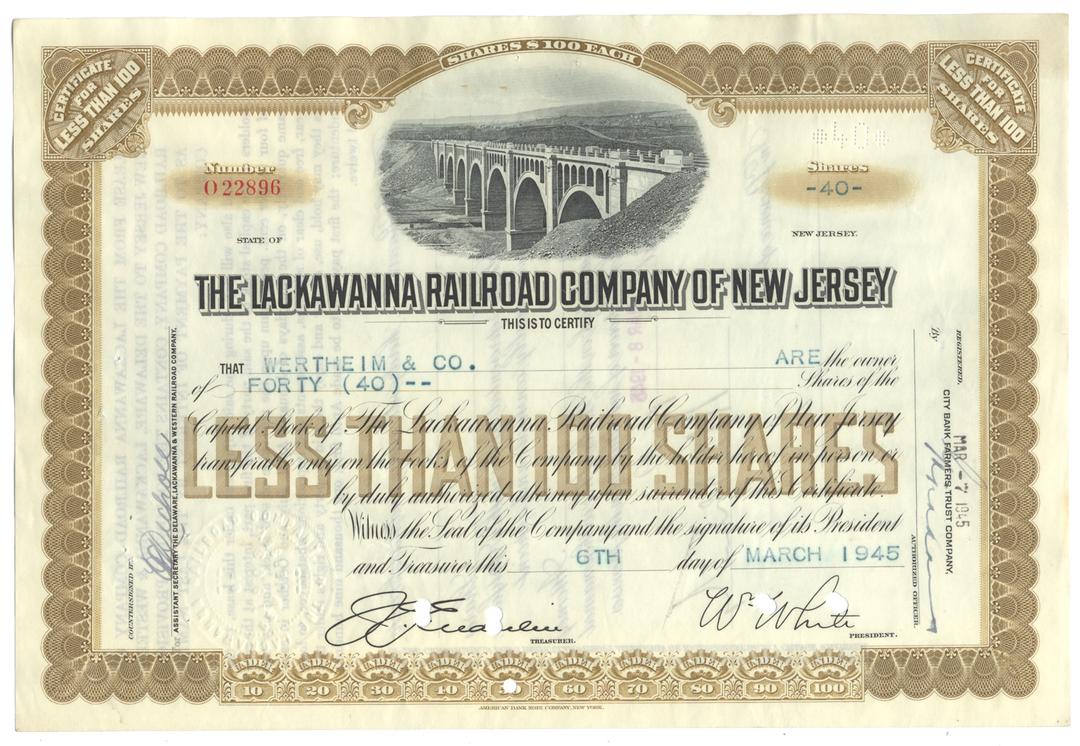
Lackawanna Railroad Company of New Jersey
- Guaranteed authentic document
- Orders over $75 ship FREE to U. S. addresses
Product Details
| Company | Lackawanna Railroad Company of New Jersey |
| Certificate Type | Capital Stock |
| Date Issued | 1920's and 1930's |
| Canceled | Yes |
| Printer | American Bank Note Company |
| Signatures | Machine printed |
| Approximate Size |
11 1/4" (w) by 7 1/2" (h) |
|
Product Images |
Representative of the piece you will receive |
| Authentic | Yes |
| Additional Details | The vignette of the Delaware River Viaduct (also known as the Hainesburg Bridge) at the Delaware Water Gap |
Historical Context
The Lackawanna Cut-Off was designed to bypass the Delaware, Lackawanna & Western's "Old Road," a circuitous route via Hackettstown and Washington, New Jersey, constructed on an alignment significantly south of where the Cut-Off would later be built, in anticipation of a potential merger with the Central Railroad of New Jersey (CNJ) which never took place. The Old Road was also built to a clearance standard that was obsolete by the beginning of the 20th Century. As such, it had become an operational bottleneck, with Oxford Tunnel, which had been converted to gauntlet track (essentially a single track), being the biggest problem of all. President William Truesdale, who became president of the Lackawanna in 1899, foresaw the need for replacing the Old Road very early on, and the concept of the New Jersey Cut-Off (as it also was known) was born.
Starting about 1905, more than a dozen potential routes between Port Morris, New Jersey and Slateford, Pennsylvania were surveyed. Several of these routes would have required significantly more tunneling than already existed on the Old Road. (Interestingly, the Cut-Off as built was not amongst these surveyed alignments.) Given that any east-west route in northwest New Jersey would cross the north-south hills at a right angle, the need for tunnels on the new route seemed inevitable, in spite of the fact that one of the major reasons for building the new route was to eliminate the two tunnels on the old route.
As planning continued, a new route — the northernmost of all the potential routes — emerged. This route would have no tunnels and would cross the valley of the Pequest River on the world's largest railroad embankment: the Pequest Fill. Indeed, the "as built" version of the Cut-Off was not initially pursued because it was deemed impossible to build due to the projected scale of the fill that would be needed to cross the valley of the Pequest River.
The Cut-Off would run from the crest of the watershed at Lake Hopatcong (Port Morris, New Jersey) to Slateford, Pennsylvania on the Delaware River, two miles south of the Delaware Water Gap. The line is 28.45 miles in length, as compared to the Old Road's 39.6 miles, saving the Lackawanna 11.15 miles between the two points. This, however, was but one element of the improvement, for it reduced the maximum grade of 1.1% to less than 0.6%. (A grade of exactly 1% is a rise or fall of 52.8 feet per mile.) Although reducing the ruling grade by 0.5% (26 feet per mile) doesn't seem like much, the difference to railroad operations is significant.
The building of the Cut-Off also eliminated a total curvature of 1,560 degrees (over four complete circles) and did away with the two tunnels at Oxford, New Jersey and Manunka Chunk, although a new 1,024-foot tunnel at Roseville would be required when construction of a cut there produced very unstable rock.
The Cut-Off cost $11 million to build. A new corporation, the Lackawanna Railroad of New Jersey (LRRNJ), was created, and remained a separate corporate entity until 1941, when it was merged into the DL&W.
Related Collections
Additional Information
Certificates carry no value on any of today's financial indexes and no transfer of ownership is implied. All items offered are collectible in nature only. So, you can frame them, but you can't cash them in!
All of our pieces are original - we do not sell reproductions. If you ever find out that one of our pieces is not authentic, you may return it for a full refund of the purchase price and any associated shipping charges.





